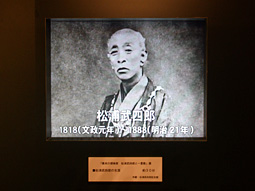 |
|
 |
| Gallery entrance |
|
Video portrait of Takeshiro Matsuura |
The two biggest sponsors of the superb cultural infrastructure that supports the profession of architecture in Japan are TOTO and INAX, both manufacturers of bathroom fittings. TOTO runs the well-known Gallery MA in Tokyo, while INAX maintains several galleries across the nation. Both companies also have publishing programs that promote interesting contemporary architects and, to a lesser extent, document new research into historical architecture. Currently touring the INAX galleries in Osaka, Nagoya, and Tokyo is an exhibition about the multitalented explorer Takeshiro Matsuura (1818-1888), focusing on his Ichijojiki -- a study room with a total floor area not much bigger than one tatami mat (intended to be just large enough for one person to lie down, a tatami mat is about 1800 x 900 mm, though the exact size varies slightly according to region). The centerpiece of the exhibition is a full-scale replica of Takeshiro's study, which visitors may enter. From outside, the space appears somewhat awkward or claustrophobic, but when sitting inside it feels entirely comfortable, a precise and intimate fit for a single human body.
Takeshiro was born in Matsusaka, a town located on the pilgrimage route leading to Ise Jingu, Japan's most important Shinto shrine (while the shrine's origins are ancient, famously the buildings are rebuilt every twenty years as part of a sacred rite of renewal). Witnessing the steady stream of passing pilgrims gave Takeshiro the urge to travel, and at the age of seventeen he began a life dedicated to exploring Japan. Having covered most of the highlights within a decade or so, he decided to head north into the uncharted territory of what was then known as Ezo. Armed with only a simple compass, he undertook the first of what was to become six expeditions that were instrumental in transforming the status of the region itself.
The name Ezo historically referred to everything north of Honshu (Japan's main island), which included Hokkaido -- a name that Takeshiro himself proposed -- as well as a large island called Karafuto, known as Sakhalin in Russian and at that time the subject of territorial disputes with Russia. The Ezo region was mainly inhabited by an indigenous ethnic group now known as the Ainu. Takeshiro became closely involved with the locals, learning their language in order to document their culture. He filled a huge number of notebooks with his observations and drawings of the daily life of the Ainu, as well as new flora and fauna he encountered. With Ainu help, Takeshiro made astonishingly detailed maps of Hokkaido, accurately delineating rivers and other geographical features while noting all the native place names. The resulting vast body of research served to introduce the Ezo region to the rest of Japan, and made Takeshiro a celebrity -- he published many books on the topic, heavily illustrated with his own sketches and woodblock prints. Just as importantly, he became a de facto activist for the Ainu people themselves. Takeshiro's sympathetic attitude toward the Ainu was influential in their gaining official recognition as Japanese citizens rather than primitives to be abused and exploited.
The exhibition includes examples of Takeshiro's original sketchbooks, calligraphy, paintings, maps, and field notes, and an extended video interview with Henry D. Smith II (Professor of Japanese History at Columbia University and Director of the Kyoto Consortium for Japanese Studies), author of the definitive work on Ichijojiki [1]. Takeshiro built his one-mat study in a corner of his home when he was close to seventy years old. It is an eclectic composition, comprising items donated by friends and admirers from across Japan, many of them from important cultural and religious sites -- notably, some of the wood was taken from the dismantling of Ise Jingu. Unfortunately, the replica in the exhibition is not made of wood, but of full-scale photo panels inside and out, turning the tokonoma alcove space into a flat image. Takeshiro specified that after his death Ichijojiki should be demolished and used as his funeral pyre. We are lucky that his descendants disobeyed him, and the original structure may be visited at its current location within the grounds of International Christian University in Tokyo.
[1] Henry D. Smith II, Taizanso and the One-Mat Room (Tokyo: International Christian University, 1993).
|